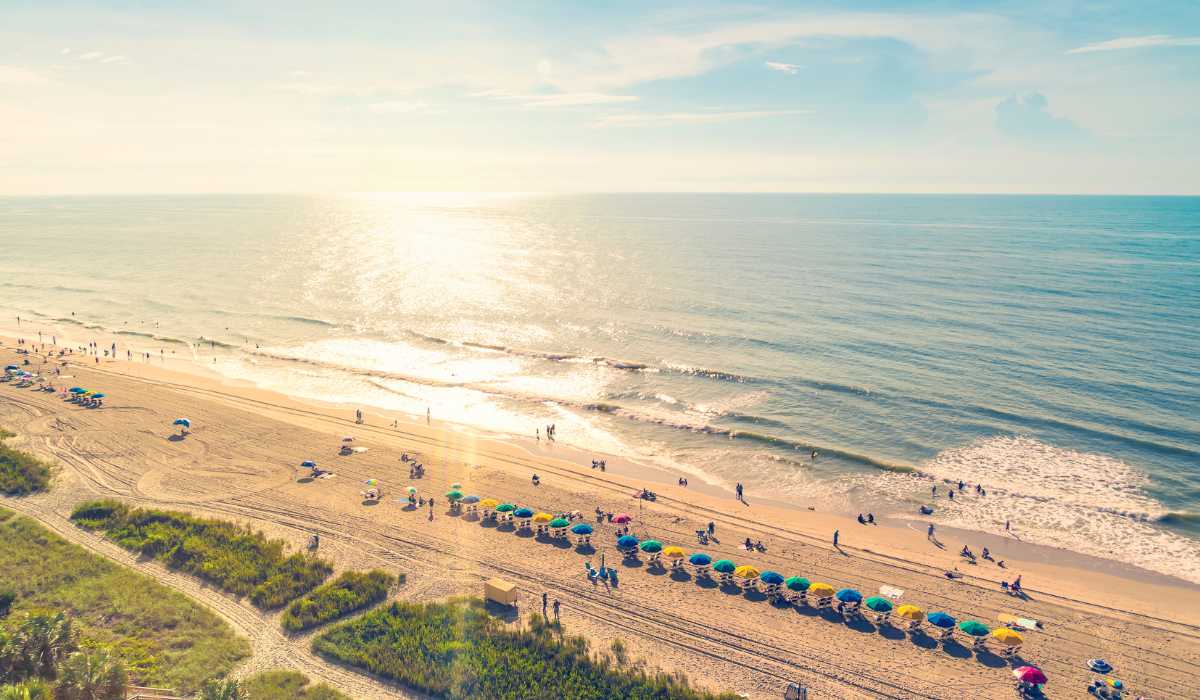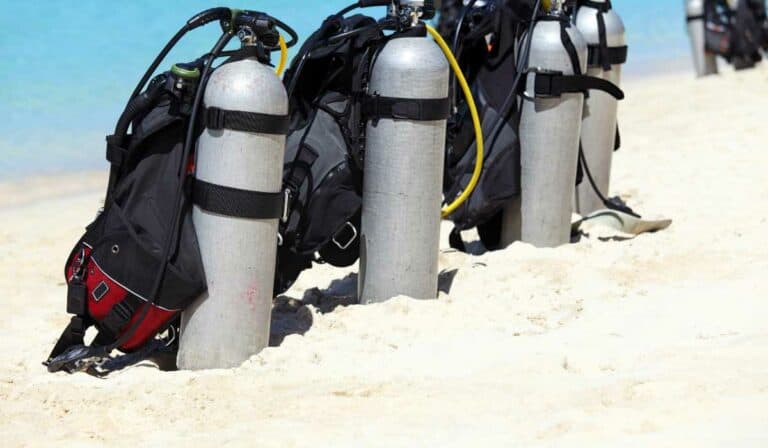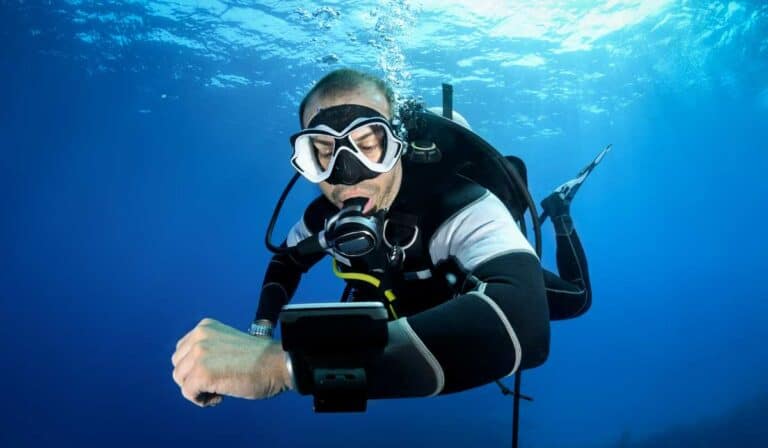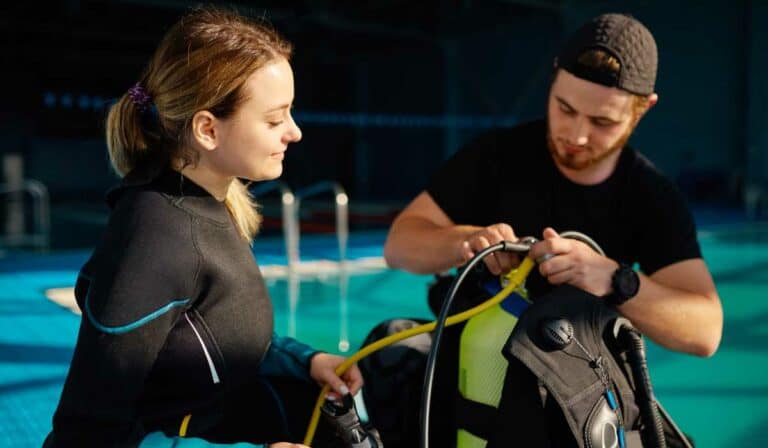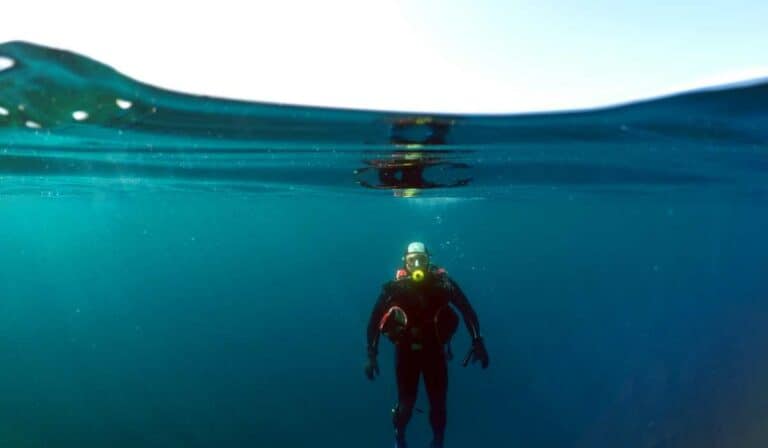Scuba Diving in South America: The Ultimate Guide
Scuba diving in South America offers a unique and thrilling experience for divers of all levels. With its diverse marine life, stunning coral reefs, and fascinating underwater landscapes, this region is truly a diver’s paradise. This post looks into the top dive sites in South America and provides insight into safety regulations, pricing, equipment needs, and ideal times to go.
We’ll discuss the cost of scuba diving in South America as well as recommended gear to make your underwater adventure both enjoyable and safe. Additionally, you’ll learn about the best time to visit these breathtaking locations so that you can plan your trip accordingly. Get ready to discover the wonders beneath the waves in Latin America’s most captivating dive spots.
Table of Contents
1. Overview of Scuba Diving in South America

For an unparalleled aquatic experience, scuba diving in South America is the perfect choice. With its diverse marine life and stunning underwater landscapes, this continent offers some of the best dive sites on the planet. To get you started on your South American scuba diving adventure, here’s a quick overview of the top countries for this activity, including information about locations, laws, and safety tips.
2. The Best Countries for Scuba Diving in South America
- Brazil: Known for its vibrant culture and beautiful beaches, Brazil is also home to some incredible dive spots like Fernando de Noronha Island and Laje de Santos Marine Park.
- Colombia: Colombia’s Caribbean coast boasts crystal-clear waters teeming with colorful marine life at popular destinations such as Tayrona National Park and Malpelo Island.
- Ecuador: The Galapagos Islands are a must-visit destination for any diver due to their unique biodiversity both above water and below.
- Venezuela: Los Roques Archipelago offers pristine coral reefs that attract divers from around the world.
In addition to these top countries, there are plenty more fantastic diving opportunities throughout other nations within South America. Keep reading as we delve deeper into each country’s specific locations later on.
Click here to read about Best Knives for Scuba Diving: Safety Tools for Exploring the Depths
3. Scuba Diving Laws and Safety Tips

Before embarking on your scuba diving adventure in South America, it’s essential to familiarize yourself with the local laws and regulations. Each country has its own set of rules governing dive certifications, marine conservation efforts, and safety measures. In addition, we will delve further into these topics later.
When underwater, safety should always be the foremost concern. Some general tips for staying safe while scuba diving include:
- Ensure you have proper certification from a recognized agency such as PADI.
- Dive within your limits and never exceed recommended depths or times.
- Maintain good communication with your dive buddy at all times.
We hope this overview has piqued your interest in exploring the underwater wonders of South America. Stay tuned as we discuss specific locations, laws, costs, gear recommendations, and more throughout this blog post series.
For those seeking an underwater adventure, South America provides a wealth of stunning seascapes and marine life to explore. From the Caribbean Sea to the Pacific Ocean, South America offers a range of stunning diving locations with something for all levels of divers. Next, we will discuss some popular scuba diving locations in South America that you should consider visiting on your next adventure.
Key Takeaway:
South America boasts some of the planet’s most remarkable scuba diving spots, with Brazil, Colombia, Ecuador, and Venezuela being among the foremost. It is important to familiarize yourself with local laws and safety measures before embarking on a dive adventure, such as having proper certification from recognized agencies like PADI and maintaining good communication with your dive buddy at all times.
4. Scuba Diving Locations in South America
South America offers a variety of stunning scuba diving destinations, with an abundance of marine life and varied underwater scenery. In this section, we will explore the best scuba diving spots in each country within South America.
Brazil
Brazil boasts an extensive coastline with numerous dive sites suitable for divers of all skill levels. Some popular spots include:
- Fernando de Noronha: A UNESCO World Heritage Site known for its crystal-clear waters and abundant marine life such as dolphins, turtles, and sharks.
- Angra dos Reis: Located near Rio de Janeiro, Angra dos Reis offers over 300 islands to explore with stunning coral reefs teeming with tropical fish.
- Bonito: This inland destination features unique freshwater dives in crystal clear rivers surrounded by lush vegetation and rich biodiversity.
Colombia
The warm Caribbean waters surrounding Colombia provide excellent conditions for scuba diving enthusiasts. Top dive sites include:
- Malamyros Reef, located off the coast of Cartagena, is renowned for its diverse array of marine life such as barracudas, stingrays, and moray eels amidst vibrant coral gardens.
- Gorgona Island National Park: Known for its hammerhead shark sightings during migration season (July – November), Gorgona Island also offers pristine coral gardens inhabited by colorful reef fish.
Ecuador & Galapagos Islands
The famous Galapagos Islands are a must-visit destination for any scuba diver. Some of the best dive sites in Ecuador and the Galapagos include:
- Darwin Island: A world-renowned site famous for its hammerhead shark schools, whale sharks, and manta rays.
- Kicker Rock: This iconic volcanic formation is home to sea turtles, eagle rays, and various species of sharks.
- Gordon Rocks: Known as “the washing machine” due to strong currents that attract large pelagic fish such as tuna and jacks.
Click here to read about Best Scuba Diving Accessories for a Comfortable and Enjoyable Dive
Venezuela
The Caribbean coast of Venezuela offers several excellent diving spots with vibrant marine life. Top locations include:
- Los Roques Archipelago National Park: This protected area features over 300 islands with pristine coral reefs inhabited by diverse marine species such as lobsters, barracudas, and nurse sharks.
As you can see from this list of incredible destinations across South America’s vast coastline, there are countless opportunities to explore underwater wonders. Whether you’re a seasoned scuba diver or just getting your feet wet, South America offers amazing aquatic experiences.
Exploring the depths of South America through scuba diving is a remarkable journey that provides numerous thrilling and extraordinary chances. Before you take the plunge into South America’s exotic waters, it is imperative to familiarize yourself with scuba diving laws and regulations.
Key Takeaway:
South America offers a diverse range of scuba diving locations, from Fernando de Noronha in Brazil to Los Roques Archipelago National Park in Venezuela. The Galapagos Islands are a must-visit destination for any scuba diver with Darwin Island being world-renowned for its hammerhead shark schools and whale sharks. No matter your level of expertise, South America offers a plethora of scuba diving opportunities to suit all.
5. Laws and Regulations for Scuba Diving in South America

To ensure a safe and enjoyable experience, it is important to be aware of the laws and regulations governing scuba diving in each country.
Argentina
In Argentina, there are no specific national laws regulating recreational scuba diving. However, dive operators must adhere to safety standards set by international organizations such as PADI or SSI. It is recommended that divers carry their certification cards with them at all times while diving.
Brazil
Brazil has established guidelines for scuba diving through its Navy Ordinance No. 397/2000 (NORMAM-03/DPC Mod 4 Capitulo 5 Secao II – Mergulho Recreativo Amador ). These guidelines mandate that divers should hold valid certifications from recognized training agencies like PADI or SSI before participating in any underwater activities. Additionally, Brazilian law requires dive operators to register with the local maritime authority.
Chile
In Chile, recreational scuba diving is regulated by the National Maritime Authority (DIRECTOR). According to DIRECTEMAR’s regulations (NORMATIVA DE BUCEO RECREATIVO N°1/2016 y N°7/2023 ), divers must possess a valid certification card issued by an internationally recognized organization like PADI or SSI before engaging in any underwater activities within Chilean waters.
Colombia
Colombia’s scuba diving regulations are governed by the Colombian Maritime Authority (DIMAR). The Resolution 184 of 2013 states that all divers must have a valid certification from an internationally recognized agency like PADI or SSI. Dive operators are also required to register with DIMAR and follow safety guidelines set forth by international organizations.
Ecuador
In Ecuador, there is no specific legislation for recreational scuba diving. Despite the lack of specific regulations, diving operators in the Galapagos must comply with strict safety protocols and conservation measures set forth by the National Park Directorate. Divers should ensure they hold a valid certification card before participating in any underwater activities.
Peru
Peruvian law does not specifically regulate recreational scuba diving; however, it is recommended that divers carry their certification cards while engaging in underwater activities within Peruvian waters. Additionally, dive operators must comply with international safety standards established by organizations such as PADI or SSI.
In summary, while each country may have its own laws and regulations regarding scuba diving, most South American nations require divers to possess valid certifications from internationally recognized agencies like PADI or SSI. It’s essential to research local rules before embarking on your adventure and always choose reputable dive operators who adhere to these guidelines for a safe and enjoyable experience.
Click here to read about Exciting Scuba Diving Books for Adventure Seekers
Before beginning your South American scuba diving journey, it is essential to be knowledgeable of the relevant laws and regulations. Before venturing into the depths of South America’s underwater world, let us explore some safety guidelines to ensure a secure and enjoyable scuba diving experience.
Key Takeaway:
Before embarking on a scuba diving trip in South America, it is essential to be mindful of the laws and regulations applicable to this activity in each country. Most countries require divers to possess valid certifications from internationally recognized agencies like PADI or SSI. Dive operators must also comply with safety standards set by international organizations for a safe and enjoyable experience.
6. Safety Tips for Scuba Diving in South America
Scuba diving can be an exhilarating experience, but it’s essential to prioritize safety while exploring the underwater world of South America. Here are some crucial safety tips to keep in mind when scuba diving across different countries on this continent.
Choose a Reputable Dive Operator
Selecting a reliable and experienced dive operator is critical for ensuring your safety during dives. Research various operators and read reviews from previous customers before making a decision. The Professional Association of Diving Instructors (PADI) website is an excellent resource for finding certified dive centers.
Become Familiar with Local Conditions
Different regions have unique underwater conditions that you should familiarize yourself with before diving. For example, currents may vary between locations or visibility might be limited due to seasonal changes. Consult local divers or your chosen dive center about specific conditions at each site.
Maintain Your Equipment Regularly
- Rinse gear: After every dive, rinse your equipment thoroughly with fresh water to remove saltwater residue and prevent corrosion.
- Inflate BCD: Inflate your buoyancy control device (BCD) fully after rinsing it out so any trapped water can drain away easily.
- Dry storage: Store all gear in a cool, dry place away from direct sunlight to prolong its lifespan.
- Servicing intervals: Follow manufacturer recommendations on servicing intervals for regulators and other vital components of your equipment set-up.
Familiarize Yourself With Local Marine Life
Before taking the plunge, become familiar with the native aquatic wildlife and gain insight on how to interact safely through researching sources such as Project AWARE Foundation. Before diving, research the local species and learn how to interact with them safely. The Project AWARE Foundation offers valuable information on marine conservation and responsible interactions with underwater creatures.
Dive Within Your Limits
It’s essential not to push yourself beyond your comfort zone or skill level while scuba diving. Stick to dive sites that match your experience and certification level, as well as ensure you have a buddy system in place for added safety.
Stay Hydrated and Well-Rested
Maintaining proper hydration levels before, during, and after dives help prevent decompression sickness (DCS). Additionally, ensure you get adequate rest between dives so your body has time to recover from the physical exertion involved in scuba diving.
Incorporating these safety tips into your South American scuba diving adventures will help ensure an enjoyable and secure experience beneath the waves.
Exploring the waters of South America through scuba diving can be a secure and gratifying experience, so long as you observe the appropriate security measures. Let’s now explore the expenses associated with this thrilling underwater activity in South America.
Key Takeaway:
It is essential to select a reliable diving operator, get acquainted with the aquatic life and environment in South America, routinely maintain your equipment, dive within one’s abilities, and stay hydrated and rested for an enjoyable scuba experience. Don’t push yourself beyond your comfort zone or skill level while diving.
7. Cost of Scuba Diving in South America

The cost of scuba diving in South America can range significantly, so it pays to shop around for the best deals. However, it’s generally more affordable than many other popular diving destinations around the world. Here are some estimated costs for scuba diving trips and equipment rental fees in various countries across South America:
Brazil
In Brazil, a two-tank dive trip usually ranges from $100 to $150 USD per person. Equipment rental is typically an additional fee that can range between $30 and $50 USD per day.
Colombia
Dive trips in Colombia tend to be quite affordable compared to other countries in the region. A two-tank dive trip may cost anywhere from $70 to $120 USD per person, with equipment rental fees ranging between $20 and $40 USD per day.
Ecuador (Galapagos Islands)
The Galapagos Islands are known for their unique marine life but also come with a higher price tag due to their remote location and protected status. Expect prices for a two-tank dive trip starting at around $250-300 USD without gear rentals included which could add another 40-60 USD/day depending on what you need.
Click here to read about The Ultimate Guide to Scuba Diving Photography
Venezuela (Los Roques Archipelago)
Scuba diving in Venezuela’s Los Roques Archipelago offers pristine waters teeming with marine life but comes at a slightly higher price point than mainland locations due to its remoteness as well as political instability affecting tourism infrastructure there. A two-tank dive trip can cost around $150 to $200 USD per person, with equipment rental fees ranging from $40 to $60 USD per day.
Argentina
In Argentina, scuba diving costs are relatively affordable. A two-tank dive trip typically ranges between $80-120 USD while gear rentals will add another $20-30 USD/day depending on what you need.
Bear in mind that these figures are only approximations and can differ due to a variety of elements, such as the period of the year, exchange rate variations, and the pricing systems employed by particular dive centers. It’s always a good idea to research your chosen destination thoroughly and contact local PADI Dive Centers for up-to-date information on their specific offerings and rates.
The expense of scuba diving in South America can differ depending on the spot, but generally, it is relatively economical. Now let’s take a peek at the apparatus you should tote for your plunge.
Key Takeaway:
Scuba diving in South America is generally more affordable than other popular destinations around the world. Prices vary depending on the country, location, and dive center you choose with two-tank dive trips ranging from $70 to $300 USD per person and equipment rental fees between $20 and $60 USD per day.
8. Recommended Gear for Scuba Diving in South America
When scuba diving in South America, it is imperative to have the correct equipment for a safe and enjoyable experience. The following list provides recommendations on what to bring when scuba diving in each country:
A. Basic Scuba Diving Equipment
- Regulator: A high-quality regulator is crucial for ensuring a steady flow of air while underwater.
- Buoyancy Control Device (BCD): This piece of equipment helps you maintain neutral buoyancy and control your depth during dives.
- Mask: Choose a comfortable mask that fits well and provides clear vision underwater.
- Snorkel: Useful for surface swimming before or after dives, especially if there are strong currents or waves present.
- Fins: Ensure they fit comfortably and provide adequate propulsion without causing strain on your legs.
- Wetsuit/Drysuit: Depending on water temperatures, choose an appropriate thickness wetsuit (e.g., a 5mm wetsuit) or invest in a drysuit for colder waters.
B. Additional Scuba Diving Gear
- Dive Computer: A must-have for monitoring depth, dive time, and decompression stops.
- Weights: Necessary to achieve neutral buoyancy and counteract the natural buoyancy of your wetsuit or drysuit.
- Dive Knife: Useful for cutting through entanglements or as a tool in emergencies.
- Torch/Flashlight: Essential for night dives or exploring caves and wrecks. Consider investing in a high-quality dive light.
C. Country-Specific Recommendations
In addition to the basic scuba diving equipment listed above, some countries may require specific gear due to local conditions:
- Brazil: A reef hook is recommended when diving in strong currents around Fernando de Noronha Island. Also, consider bringing an underwater camera to capture the stunning marine life found here.
- Colombia: If you plan on diving at Malpelo Island, be prepared with extra safety equipment such as surface marker buoys (SMBs) and signaling devices due to its remote location.
- Ecuador (Galapagos Islands): A thicker wetsuit (5mm – 7mm) or even a drysuit is advised because of colder water temperatures year-round. Additionally, bring gloves and hoods for extra warmth.
Remember to always check the specific requirements and recommendations for each dive site before your trip. It’s also a good idea to consult with local dive centers or instructors, as they can provide valuable insights on what gear is best suited for their region.
Essential equipment for scuba diving in South America is a must to guarantee an enjoyable and secure journey. Next, we’ll explore when the best time of year is to go scuba diving in this region so you can plan your trip accordingly.
Key Takeaway:
To ensure a safe and enjoyable scuba diving experience in South America, it is essential to have the necessary equipment. Basic equipment includes a regulator, BCD, mask, snorkel, fins, and wetsuit/drysuit while additional gear like dive computer, weights and torch/flashlight may also be necessary. Country-specific recommendations include using reef hooks in Brazil for strong currents or thicker wetsuits in Ecuador’s Galapagos Islands due to colder water temperatures year-round.
9. Best Time To Go Scuba Diving In South America

South America offers a wide range of scuba diving experiences, with each country having its own unique underwater attractions and ideal times to visit. The ideal time for scuba diving in South America is contingent upon the destination, along with elements such as climate, water temperature, and sightings of aquatic life.
Argentina
In Argentina, the prime season for scuba diving is from November to April when water temperatures are warmer and visibility is at its best. During this period, divers can explore shipwrecks off the coast of Buenos Aires or dive among sea lions in Puerto Madryn.
Brazil
Brazil’s vast coastline provides numerous opportunities for incredible dives throughout the year. However, the optimal time for exploring Brazil’s underwater world is between December and March when waters are warmest and visibility is highest. This period also coincides with increased chances of spotting turtles, rays, sharks, dolphins, and various species of fish.
- Fernando de Noronha: January – June (best visibility)
- Angra dos Reis: October – February (warmer waters)
- Bonito: March – September (clearer rivers)
Colombia
The tropical climate around Colombia’s Caribbean coast makes it an excellent destination for scuba diving all year round; however, Colombia’s dive sites are at their best between April and November. This period sees calmer seas, better visibility, and increased chances of encountering marine life such as turtles, rays, and barracudas.
Ecuador
Scuba diving in Ecuador, particularly around the Galapagos Islands, is a year-round activity with two distinct seasons:
- Warm season: December – May (calm waters & higher water temperatures)
- Cool season: June – November (increased nutrient-rich currents attracting more marine life)
The choice between these two seasons depends on your personal preferences for water temperature and the specific species you wish to encounter during your dives.
Venezuela
In Venezuela’s Los Roques Archipelago – one of South America’s top scuba diving destinations – the ideal time to dive is from March to September when winds are lighter and underwater visibility can reach up to 30 meters. During this time, Venezuelan waters offer an abundance of colorful coral reefs teeming with diverse marine life including sea turtles, eagle rays, nurse sharks, and moray eels.
Key Takeaway:
South America offers a diverse range of scuba diving experiences, with each country having its own unique underwater attractions and ideal times to visit. The optimal time for scuba diving in South America is contingent on the chosen destination, as well as elements such as climate, water temperature, and marine life sightings. From exploring shipwrecks off the coast of Buenos Aires to encountering sea turtles in Venezuela’s Los Roques Archipelago, there are plenty of opportunities for adventure beneath the waves.
FAQs Scuba About Diving in South America
Where is scuba diving most popular in the world?
Scuba diving is most popular in tropical and subtropical regions, with top destinations including the Great Barrier Reef in Australia, the Red Sea in Egypt, and the Caribbean. These locations offer diverse marine life, clear waters, and favorable weather conditions for divers.
Where is the scuba diving capital of the world?
The island of Bonaire, located in the southern Caribbean near Venezuela, is often considered the scuba diving capital of the world. It boasts pristine coral reefs teeming with vibrant marine life and offers over 80 dive sites accessible from shore or boat.
What is the most common problem faced by scuba divers?
The most common problem faced by scuba divers is barotrauma – injuries caused by changes in air pressure during ascent or descent. Ear barotrauma, also known as ear squeeze or middle ear equalization problems, is particularly frequent among beginners who may struggle to properly equalize their ears while underwater.
What are some fun facts about scuba diving?
The word SCUBA stands for Self-Contained Underwater Breathing Apparatus.
Jacques Cousteau, a French naval officer, and explorer, co-invented modern-day Scuba equipment along with Emile Gagnan back in 1942-43.
The ancient Greek philosopher Aristotle mentioned a diving bell, an early form of underwater exploration device, in his writings around 350 BCE.
Scuba divers can explore various environments like coral reefs, shipwrecks, caves, and even underwater volcanoes.
Scuba Diving in South America?
South America is home to some of the world’s most spectacular scuba diving sites. From the Galapagos Islands to the Robinson Crusoe Islands, there are plenty of opportunities to explore the underwater world in this region.
Galapagos Islands, Ecuador?
The Galapagos Islands are a UNESCO World Heritage Site and a bucket list destination for scuba divers. The islands are located off the coast of Ecuador and are home to a diverse range of marine life, including whale sharks, hammerhead sharks, sea turtles, and sea lions. The best time to visit for scuba diving is from June to November when the water is cooler and clearer.
COCOS ISLAND, COSTA RICA?
Cocos Island is a remote island located off the coast of Costa Rica and is known for its shark diving. Divers can encounter hammerhead sharks, tiger sharks, and whale sharks in the waters surrounding the island. The best time to visit is from June to December when the water is warmer and the visibility is better.
Conclusion
Exploring the diverse marine life and underwater landscapes of South America, scuba diving offers an incredible experience. From the colorful coral reefs of Brazil to the mysterious shipwrecks off the coast of Colombia, there are countless scuba diving locations waiting to be discovered.
Before you dive into your South American scuba adventure, make sure to research local laws and regulations, safety tips, gear recommendations, and cost-effective times for the best experience. Additionally, understanding the cost and best time to go can help you plan a successful trip.

